The information on this page is correct as at 18/10/2025 to the best of Contentsquare's understanding.
Pendo and Contentsquare are both top-rated platforms that are frequently compared to each other. Which one is better for your use cases? That depends on what you are trying to accomplish, which products from Pendo and Contentsquare you are comparing, and what other tools you already have in place.
TL;DR
Pendo and Contentsquare are often compared with each other for their rivaling Product Analytics solutions. In this comparison, the customers that select Contentsquare often do so because of its more granular analytical capabilities, data governance features that make auto captured data more practical to use, its digital experience analytics capabilities, and Contentsquare's autocapture in Product Analytics has been refined over 10 years of R&D investment.
It seamlessly captures in-page behavioral events on both websites and mobile apps.
This feature consistently delivers significant time and cost savings compared to traditional analytics tools, which demand extensive pre-planning and the deployment of new tags for every new question.
It frees up engineering teams to concentrate on core development tasks, rather than manual tagging.
It minimizes data clutter through governance features that store all autocaptured events while only highlighting the most relevant ones.
Ultimately, it provides a comprehensive data set, empowering users to get quicker, more precise, and retroactive answers to their inquiries.
Examples of more granular analytical insights in Contentsquare Product Analytics include
Funnels with automated data science algorithms to reveal hidden friction and opportunity in the user experience
Engagement matrix: Charts features by volume and frequency of use to understand high value features
Conversion impact of features clicked
Automated data feeds into data warehouses via Data Connect
And many more
The addition of Experience Analytics in Contentsquare
Provides not just basic session replay as many other Product Analytics vendors do, but a complete platform for digital experience analytics, monitoring, and voice of customer
Enables companies to create content experiences that convert better by understanding how users see their sites and apps, what content elements attract them before they click, and why do they bounce or convert
Enables friction-free experiences by surfacing frustrations and their root causes, ranging from technical errors to slow speeds and UX problems.
Helps create happy users by collecting feedback directly via surveys, user feedback, usability tests, and interviews using Contentsquare Voice of Customer.
At times, Pendo customers compare it directly to Contentsquare’s Experience Analytics product and find that there is very little overlap when comparing these two products. That’s why many companies use Pendo and Contentsquare Experience Analytics together to reap their synergies. In this combination, Pendo provides analytics for what is happening and Contentsquare Experience Analytics answers why it’s happening.
Beyond these core analytics capabilities, many Pendo customers value their platform for its native product walkthrough guides and user engagement orchestration capabilities. Contentsquare does not offer a comparable capability for guides natively but instead provides over 115 integrations with best-of-breed partners including also for product walkthrough guides, personalization, A/B testing, CDP, and many other use cases. When companies have their preferred ecosystem of solutions already in place, the ability to integrate with their existing tools is valued most highly.
What are the main differences between Contentsquare vs. Pendo?
Instead of jumping into a tool comparison, start from your business goals. What are your biggest business challenges? Choose the platform that’s designed to help you achieve your goals.
Here’s an overview of the main use case differences between Contentsquare vs. Pendo from our perspective
Typical business goals and use cases | Contentsquare | Pendo |
|---|---|---|
Does it help create better products and drive user adoption and growth with the help of data and experimentation? | Yes, absolutely | Yes, absolutely |
Does it support making customers happier by collecting their feedback and making sense of it? | Yes, absolutely | Yes, absolutely |
How do we create better products and drive user adoption and growth? | Very Strong | Strong, but relatively more limited on analytics and data governance |
How do we improve marketing acquisition? | Very Strong | Medium |
How do we improve content experiences and engagement? | Very Strong | Light |
How do we surface obstacles and prioritize what to fix based on revenue impact? | Very Strong | Very light |
How do we create happier customers by collecting their feedback and making sense of it? | Medium | Medium |
Native products beyond analytics? | 100+ integrationswith best of breed providers | Very Strong, e.g. Guides, Orchestration/ |
How do we create better products and drive user adoption and growth?
Both Contentsquare Product Analytics and Pendo are market leaders for web, app, and product analytics capabilities.
On the analytics side of their Product Experience Platform, Pendo provides product analytics used by product teams to understand user behavior and make data-driven decisions.
Since acquiring Heap in 2023, Contentsquare is now a comparable Pendo alternative, with full product analytics capabilities plus additional tools for retention analysis and user segmentation.
Both Contentsquare vs. Pendo are popular alternatives to product analytics competitors like Amplitude and Mixpanel or Hotjar. Use either to
Report on sign-ups and product usage
Measure onboarding and feature engagement
Stitch user behaviors across sessions and devices
Track retention and run cohort analysis
Create custom product analytics dashboards for different teams with templates for common use cases
Measure the success of SaaS products and ecommerce stores
![[Visual] Retention analysis example in Pendo vs. Contentsquare](http://images.ctfassets.net/gwbpo1m641r7/20eJzeuoJNYHD3cOzDoUuU/58426f93140212c757625505bff979fb/unnamed-2024-10-18T104724.668.png?w=1920&q=100&fit=fill&fm=avif)
The biggest difference between Contentsquare Product Analytics and Pendo are the set-up and depth of analytical insights.
Contentsquare provides the marketing leading Autocapture.
Both Pendo and Contentsquare provide autocapture capabilities but Contentsquare has refined its auto capture capabilities for websites and mobile apps with a focus on data governance features that provide insights while reducing the noise.
Contentsquare's autocapture is a market-proven solution that offers significant advantages for comprehensively understanding in-page interactions, allowing teams to answer daily questions without the hassle of manual tagging:
No advance planning needed: Contentsquare automatically captures all in-page clicks, taps, field interactions, and more, eliminating the need to decide what to track beforehand.
Empower engineering: No need to involve engineers every time a tracking change is required, freeing them to focus on their core responsibilities.
Analyze historical data with ease: With retroactive data, anyone can troubleshoot or analyze any data point from the past at any time.
Eliminate data blind spots: Never worry about missing critical data again. A more complete dataset ensures you get better and faster answers to your questions.
Data governance features: Reduce the noise by surfacing only the behaviors that matter, while keeping the rest of the auto capture data in the backpocket. Rest assured that you can always retrieve additional events from the back pocket whenever needed, and mine it with Contentsquare’s automated data science algorithms
Reduce total cost of ownership: Save a significant amount of effort and money typically spent on manual tagging with traditional analytics tools.
Lower fees: Avoid the extra charges from analytics tools that bill based on the number of captured events, as you won't be increasing your tagged events.
This approach saves time, money, reduces technical debt, and ensures you always have the data you need to make informed decisions. And it works right out of the box.
![[Visual] Manual tracking vs. autocapture](http://images.ctfassets.net/gwbpo1m641r7/1upLvWnDjOib3mspiWbMAP/f92482cc550184dfe41747b6a0ad3e6e/unnamed-2024-10-18T104718.598.png?w=3840&q=100&fit=fill&fm=avif)
More granular analytical insights in Contentsquare
Both Pendo and Contentsquare provide high level reports on product and feature adoption. However, as a best-of-breed solution focused purely on the needs for data and insights, Contentsquare Product Analytics goes deeper in regards to the types of questions it can answer. Examples of additional capabilities found in Contentsquare Product Analytics include
Funnels with automated data science algorithms to reveal hidden friction and opportunity in the user experience, e.g. events that impact drop off at funnel steps
Engagement matrix: Charts features by volume and frequency of use to understand high value features and how engagement varies across segments, such as mobile users versus web users
Conversion impact of features clicked
Automated data feeds into data warehouses via Connect
And many more
![[Visual] Example pendoo vs CSQ](http://images.ctfassets.net/gwbpo1m641r7/33RTXcu86er7qyjzKWueSX/5d43b27d4ba4d6fec26f8bbd25fea9cf/unnamed-2024-10-18T104715.785.png?w=3840&q=100&fit=fill&fm=avif)
“Within minutes of getting into Contentsquare Product Analytics (powered by Heap), we answered questions we had struggled to even approach with Pendo.” — Mike Siegel, Senior Product Manager – Splash
How do we create happier customers by collecting feedback and listening better?
Voice of Customer (VoC) feedback gives you direct access to what’s going on in the minds of your most important business asset—your customers and product users. For that reason, Pendo and Contentsquare, both provide native VoC tools.
Both Contentsquare and Pendo provide
User Feedback Collection: Gather qualitative feedback directly from users via surveys and feedback widgets
User testing: Set up tests for your users to understand how to improve features
Integration with Product Analytics insights: allowing teams to combine feedback with behavioral data to create more personalized and data-backed product strategies empowered by Sense AI.
Pendo is additionally expanding Pendo Listen with their recent acquisition of Zelta AI
“Zelta will become part of Pendo Listen, enabling product teams to get AI-powered insights from troves of their user feedback data spread across 150+ sources, like Gong and Zoom calls, support tickets, social review sites, Salesforce records, email and more.”
With Contentsquare, you have the option to integrate with leading Voice of Customer tools or use Contentsquare’s built-in VoC tools. In both cases, the benefit of choosing Contentsquare for Voice of Customer use cases is the ability to make sense of feedback at scale with the help of
Session replay: 1-click to replay experiences leading up to feedback
Segmentation, e.g. for Journey Analysis and Heatmaps: Compare journeys and behaviors of users that rated experiences highly vs. poorly
Root cause analysis: Combine Voice of Customer with Contentsquare Experience Analytics to reveal why users are running into frustrations, e.g. whether it is due to slow speeds, technical errors, UX confusion, or all of the above
1-click Impact Quantification from replay: Zoom out from any one feedback to all users to quantify how many other users ran into the same frustrations even if they didn’t leave feedback, and what was the impact on conversion and revenue.
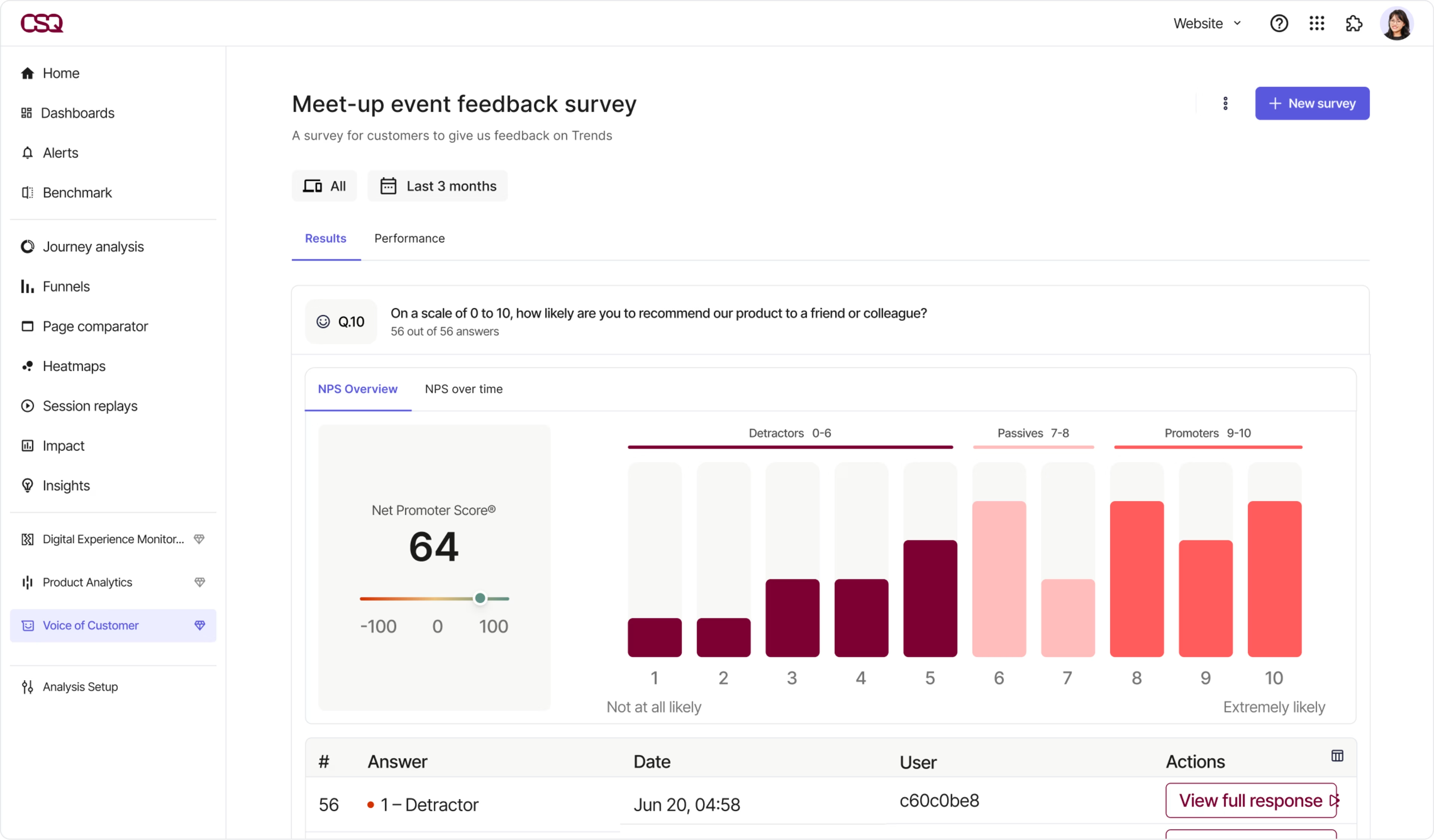
What Contentsquare does better than Pendo (and why it matters)
If you’re scrolling through the two vendor’s homepages, Contentsquare and Pendo could look pretty similar—collect data, put it in charts, use it to drive growth, rinse and repeat. But there are plenty of use cases where Contentsquare provides tools that are not a focus for Pendo’s product suite.
Here are the main things to know.
How do we improve marketing acquisition?
For marketers working on acquisition challenges, both Pendo and Contentsquare provide high-level metrics on campaign traffic and conversion, but Contentsquare Product Analytics does so with out of box capabilities, i.e. no need to set up custom events.
Contentsquare’s Product Analytics capabilities let you gain deep insight into your customer acquisition channels, e.g. traffic and conversion metrics by campaign..
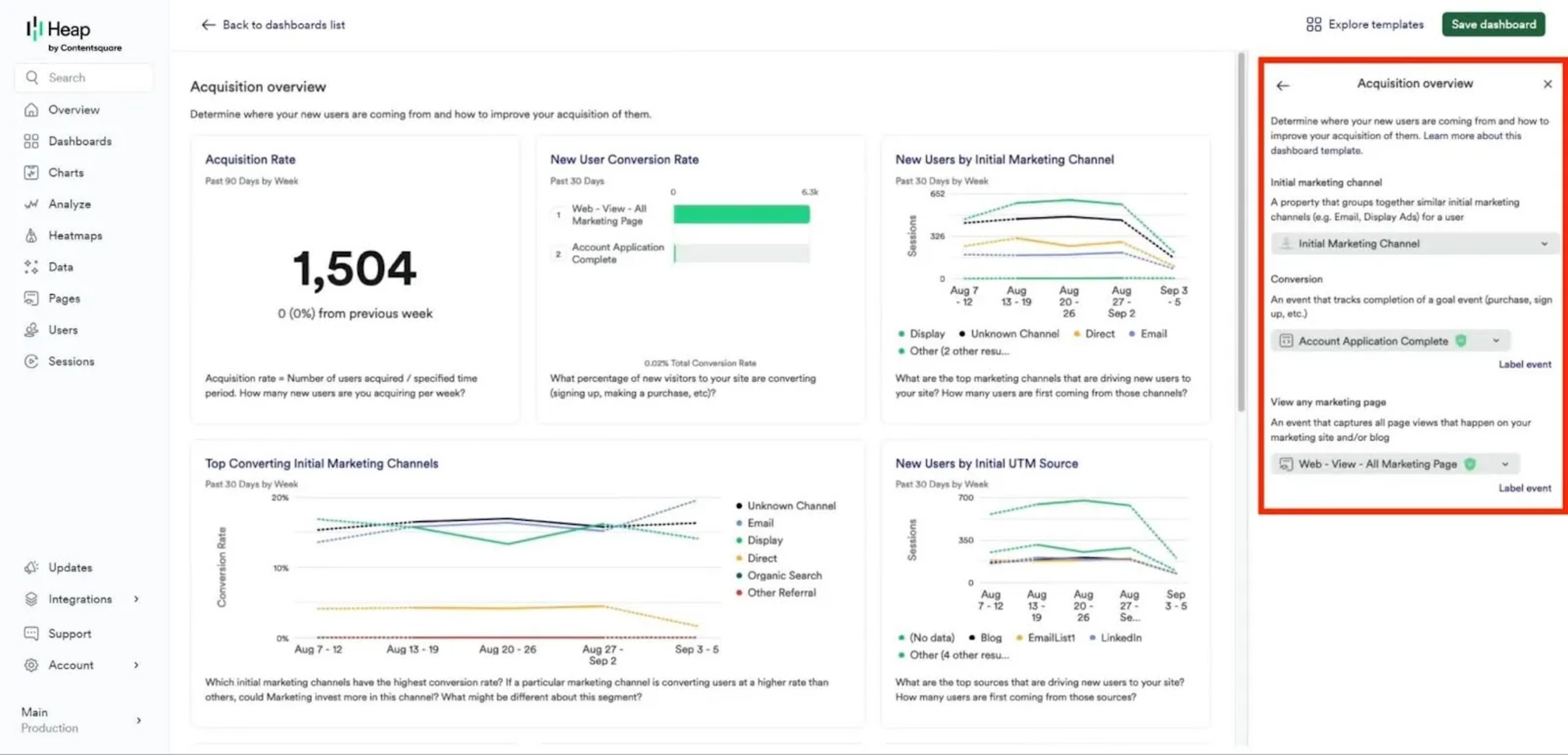
With the addition of Contentsquare Experience Analytics, your firepower for increasing Marketing ROI goes up dramatically.
Visual analytics
With Contentsquare Experience Analytics added to your ecosystem**, you also get comprehensive visual analytics for improving Marketing ROI:**
Zone-Based Heatmaps show exactly which elements are driving conversions and revenue, e.g. on campaign landing pages —use them to make a case for changes, demonstrate the success of an experiment, and compare side-by-side segment behavior
Live Zoning overlays metrics directly onto your website—use the CS Live Chrome extension to visualize how people interact within your website pages in real-time
Sunburst Journey Maps visualize customer journeys in a way that is more helpful for discovery of unexpected behaviors. It displays a top-down view of all user flow through the entire website or app at one glance. Similar pages are grouped into page types to reduce the noise It even lets you compare journeys side by side to understand differences in journeys for marketing acquired users that complete their journeys vs. those that bail along the way.
By combining visual analytics and traditional charts, Contentsquare gives you ways to understand why marketing acquired traffic is bouncing and what content A/B tests are most likely to improve results. That use case of informing the best A/B tests to run for reducing bounces and increasing conversions is one of the biggest value-drivers for companies using Contentsquare Digital Experience Analytics for improving marketing acquisition.
Visual, side by side insights for A/B testing programs in Contentsquare
Another example of Contentsquare’s value for improving Marketing ROI is through its integration with all leading A/B testing platforms, including Adobe Target, AB Tasty, Optimizely, Monetate, Kaneleoono, and VWO.
For Marketers looking to run A/B tests for reducing bounces and increasing marketing campaign conversions, these integrations help to improve results in 3 ways:
Use Contentsquare’s AI-powered insights to identify new opportunities for experimentation, i.e. what are the best tests to run that are most likely to move the needle?
See exactly what impacts conversions and revenue during the tests using side-by-side Zone-based Heatmaps
Understand exactly why variants won (and lost) to iterate more effectively on future tests and design changes
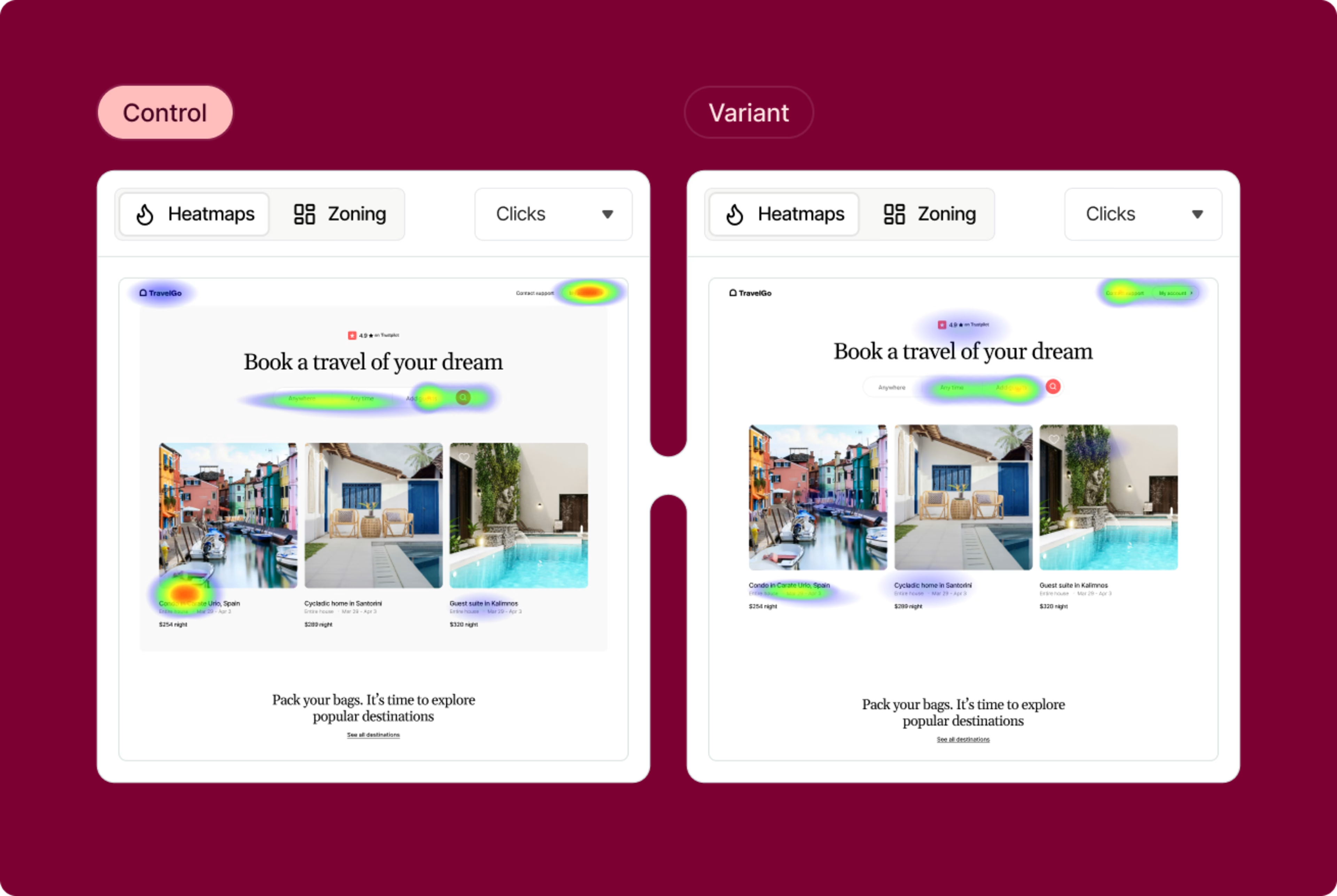
Visualize the outcome of A/B test variants with side-by-side Zone-Based Heatmaps in Contentsquare
The result is a faster path to Marketing ROI, a win win.
Import Google Advertising Audiences into Contentsquare to visualize and troubleshoot their experiences
With Google’s dominance for digital marketing, many of your ad investments will naturally be through Google’s advertising products. That’s where Contentsquare’s integration with Google makes it easier to improve your ROI on Google ad campaigns.
As documented In Google Analytics 4 (GA4) help pages, “Audiences [in GA4] are groups of users […] who have generated similar behavioral data or who share demographic or other descriptive data (e.g., same age group, same gender, were acquired by the same campaign). You can share audiences with the advertising products you use, like Google Ads, so you can market to specific groups of users.”
Wouldn’t it be helpful if you could import those same Google Ads Audience definitions into Contentsquare to gain immersive visual insights into their behavior when they browse your site? What content attracts them vs. doesn’t? What is their intent? What are their experiences?
That’s exactly what you can do with the integration between Contentsquare Experience Analytics and GA4.
Seamlessly bring your GA4 Audiences into Contentsquare to enhance your analysis and insights.
Filter any heatmap or search for replays by selecting the imported GA4 Audiences
Find improvement opportunities for journeys and content based on the audience’s wants and needs as demonstrated by their behaviors and struggles
Apply those lessons learned back to your ad campaigns in the Google Marketing Platform
How do we identify and prioritize issue resolution for revenue impact?
Understanding user frustration: No company can afford to lose customers due to frustrating experiences on their websites and apps. Session Replay helps you truly understand what users are experiencing by stepping into their shoes.
Beyond basic Replay: While Pendo has recently added session replay, Digital Experience Analytics and Monitoring tools like Contentsquare offer much more. They're designed to help you not only identify points of friction but also their root causes and actual business impact.
Technical error analytics and resolution
Using Contentsquare you can also
Combine Error Monitoring + Session Replays for websites and mobile apps —automatically detect errors, then view relevant session replays to see exactly what users experienced before, during, and after the error occurred, e.g. JS errors, API errors, app crashes, console logged errors, and custom defined errors such as form validations.
Prioritize effectively with FRUSTRATION SCORING + SESSION REPLAYS: Quickly identify and review the most insightful sessions by ranking them based on potential frustration.
Empower Advanced Support teams: Resolve escalated issues efficiently by replaying precise customer service ticket-related sessions, uncovering root causes through detailed errors, network specifics, and request/response headers and bodies.
Maintain robust security: Grant access to customer data only to authorized personnel, ensuring secure handling of service tickets.
Equip engineers with comprehensive insights: Provide engineers with a full waterfall of network details within every session recording, enabling them to quickly understand and fix bugs.
Stay ahead with real-time alerts: Utilize customizable real-time error alerts and dashboards to promptly alert your team to critical issues.
Streamline workflows: Easily create Jira tickets or rally teams to action via Slack and Microsoft Teams.
![[Visual] Frustration score](http://images.ctfassets.net/gwbpo1m641r7/7pI87Hr7R09euoIW2AGziS/c95d2b851d25ee2e6a97f49baba2703e/Screenshot_2024-11-04_at_23.18.45.png?w=3840&q=100&fit=fill&fm=avif)
Save time focusing in high-impact optimizations with Contentsquare’s AI-powered insights such as Frustration Score
![[Visual] Error details](http://images.ctfassets.net/gwbpo1m641r7/61ACMUfIGLexf0Ir0Vgd9F/7afd057bee29e6c772c6ad2759efd68b/Screenshot_2024-11-05_at_17.42.42.png?w=3840&q=100&fit=fill&fm=avif)
Perhaps the two most popular capabilities in Contentsquare for technical teams tasked with ensuring friction-free experiences are text search and 1-click impact quantification.
Only Contentsquare provides retroactive text search which enables teams to
Surface and quantify all occurrences where site users encountered unexpected error messages of any kind, e.g. “Oops, something went wrong.”
Visualize how users experience these messages,
To learn things that technical teams didn’t already know from their APM tools such as Dynatrace, Datadog, etc.,
Only Contentsquare enables 1-click impact quantification of behaviors and errors directly from session replay.
Spot any issue or error? Simply select the issue or behaviors leading up to it and quantify with one click to see how many others experience the same problems
Contentsquare automatically compares the segment of customers that experience the issue vs. those that don’t experience it at that point to calculate the true impact of the problem
This is what enables teams to go from one to many and prioritize the issues that will actually move the needle for the business and for customers.
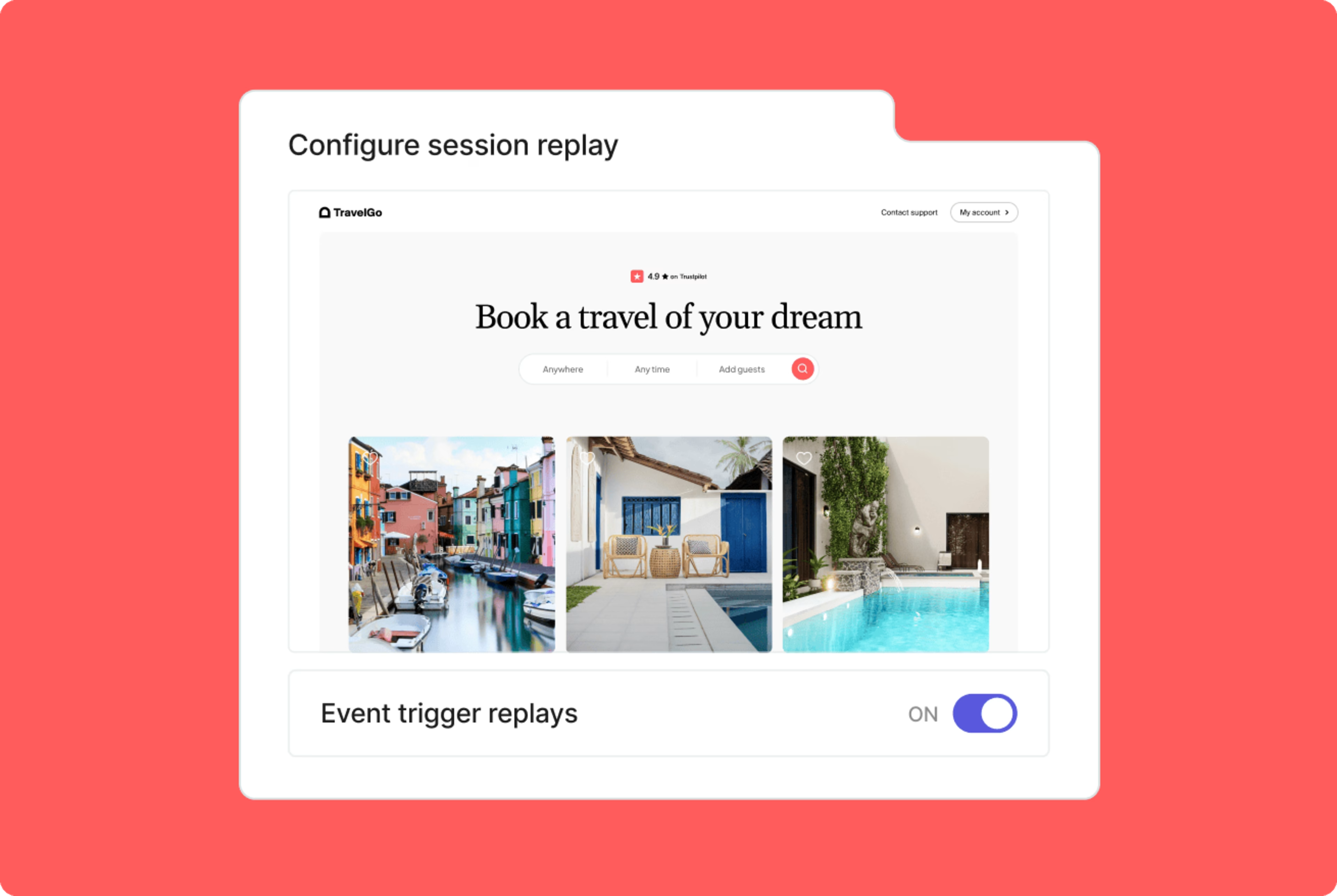
Example of error capture and impact quantification in Contentsquare
Speed Analysis
There is more than just errors, though, that causes users to abandon. Slow speeds will be enough to turn off users. So, Contentsquare helps you identify where the site is too slow so that users are losing interest.
Contentsquare provides speed analysis based on real user monitoring (RUM) to identify performance issues affecting conversion. Most importantly, this lets you quantify the conversion impact of slow speeds.
Contentsquare also provides additional Speed Analysis tools based on Synthetic Monitoring, i.e. lab testing. Teams use these to
Speed test new product releases before launching them to avoid costly blunders.
Automatically speed test production experiences to get alerted if performance degrades.
Get automated tips for what is hurting performance and how to speed it up.
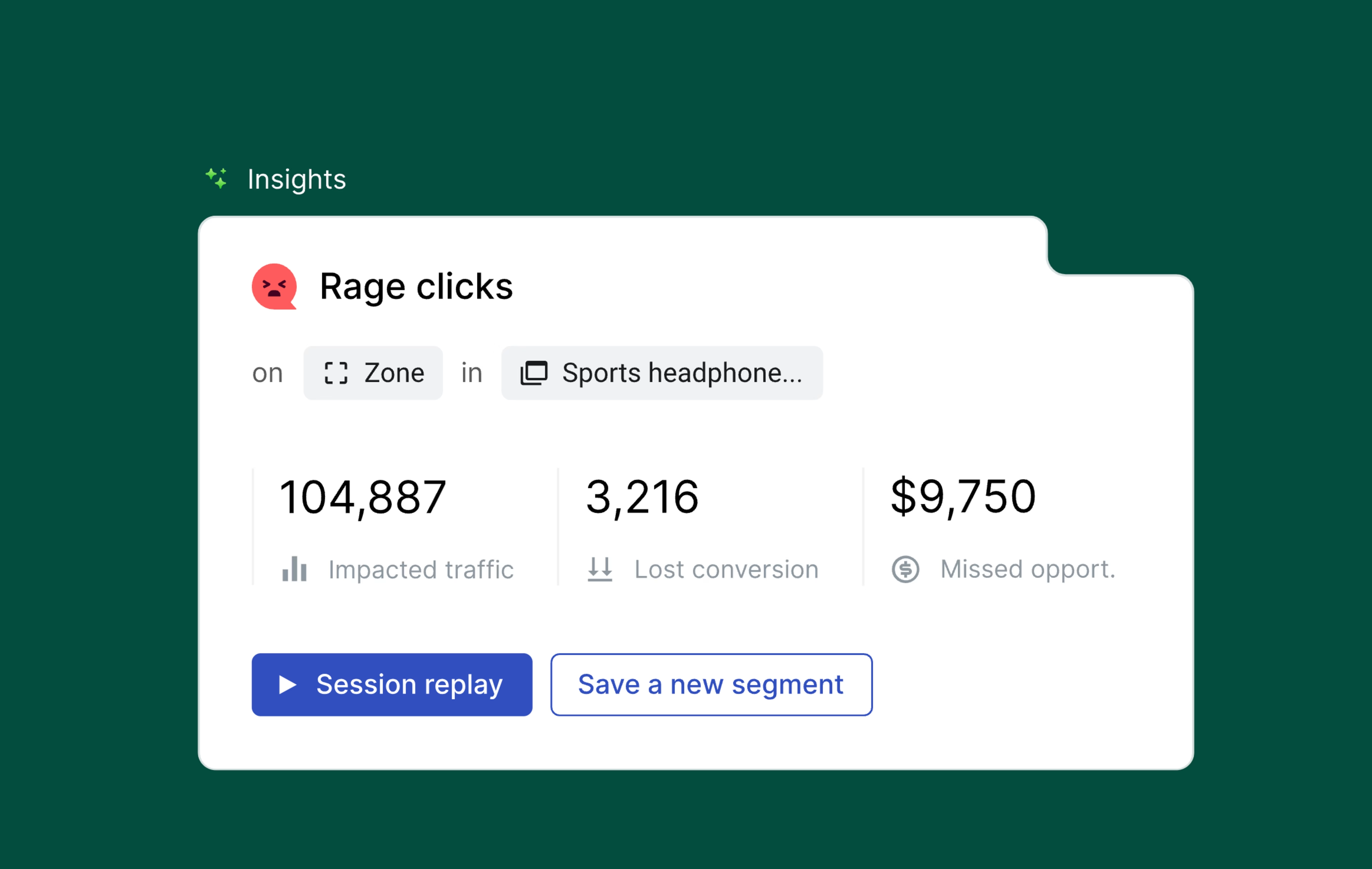
Example of quantifying the business impact of poor performance
UX Problems
Even when websites and apps function as intended, users often face confusion and frustration. Addressing these issues demands more than just link click data from typical product analytics tools. With Contentsquare, for instance, you can also visualize:
Clicks on un-clickable content: Identify instances where users attempt to interact with non-functional elements they perceive as clickable.
Recurring or rage clicks: Pinpoint these clear indicators that something is amiss, signaling user frustration.
Clicks leading to errors: Quickly identify interaction points that result in errors for users.
Multiple repeated form field interactions: Spot signs of user struggle and excessive effort when completing forms.
Automated form analysis: Gain insights into form performance with key metrics like drop-rates, refill-rates, and blank rates.
Side-by-side journey analysis: Compare user paths, for example, contrasting 5-star versus 1-star rated experiences.
Replays of Voice of Customer feedback: Directly observe the context behind user feedback. And much more.
The extensive capabilities for Experience Monitoring in Contentsquare make it a clear choice for technical teams seeking to ensure seamless operations, whether they use it in conjunction with Pendo or Contentsquare Product Analytics.
Is Contentsquare or Pendo better for your team?
What’s your primary reason for using a platform like Contentsquare, Pendo or alternatives? If it’s primarily about product walkthrough guides and user engagement, Pendo will be the better choice.
But if it is about deeply understanding users and their journeys to answer everyday questions at scale, Contentsquare Product Analytics has proven itself to be providing those answers thanks to more granular insights and a superset of capabilities for autocapture combined with data governance.
If it’s whole-business growth, Contentsquare goes even further as the only all-in-one platform that combines product and comprehensive experience analytics, monitoring, and Voice of Customer feedback to tackle growth from all angles.
Ready to see which solution fits your team best? Take the 6-minute Contentsquare product tour to discover how we turn your data into growth-driving insights.
FAQs about Contentsquare vs. Pendo
Net Promoter®, NPS®, NPS Prism®, and the NPS-related emoticons are registered trademarks of Bain & Company, Inc., NICE Systems, Inc., and Fred Reichheld. Net Promoter ScoreSM and Net Promoter SystemSM are service marks of Bain & Company, Inc., NICE Systems, Inc., and Fred Reichheld.
![[Visual] Contentsquare's Content Team](http://images.ctfassets.net/gwbpo1m641r7/3IVEUbRzFIoC9mf5EJ2qHY/f25ccd2131dfd63f5c63b5b92cc4ba20/Copy_of_Copy_of_BLOG-icp-8117438.jpeg?w=1920&q=100&fit=fill&fm=avif)
We’re an international team of content experts and writers with a passion for all things customer experience (CX). From best practices to the hottest trends in digital, we’ve got it covered. Explore our guides to learn everything you need to know to create experiences that your customers will love. Happy reading!
